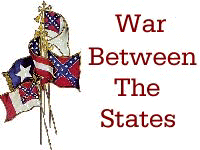| |
|
|
Important Events in 1864
February 20, 1864-- Olustee Florida
In February, the commander of the Department of the South, Maj. Gen. Quincy
A. Gillmore, launched an expedition into Florida to secure Union enclaves, sever Rebel supply routes, and recruit black soldiers. Brig. Gen. Truman Seymour moved deep into the state, occupying, destroying, and liberating, meeting little resistance on February 20, he approached Brig. Gen. Joseph Finegan's 5,000 Confederates entrenched near Olustee. One infantry brigade pushed out to meet Seymour's advance units. The Union forces attacked but were repulsed. The battle raged, and as Finegan committed the last of his reserves, the Union line broke and began to retreat. Finegan did not exploit the retreat, allowing most of the fleeing Union forces to reach Jacksonville.
May, 1864-- Grant's Wilderness Campaign
General Grant, promoted to commander of the Union armies, planned to engage Lee's forces in Virginia until they were destroyed. North and South met and fought in an inconclusive three- day battle in the Wilderness. Lee inflicted more casualties on the Union forces than his own army incurred, but unlike Grant, he had no replacements.
May, 1864-- The Battle of Spotsylvania.
General Grant continued to attack Lee. At Spotsylvania Court House, he fought for five days, vowing to fight all summer if necessary.
May 20, 1864-- Ware Bottom Church
Confederate forces under General P.G.T. Beauregard attacked Butler's
Bermuda Hundred line near Ware Bottom Church. About 10,000 troops were involved in this action. After driving back Butler's advanced pickets, the Confederates constructed the Howlett Line, effectively bottling up the Federals at Bermuda Hundred. Confederate victories at Proctor's Creek and Ware Bottom Church enabled Beauregard to detach strong reinforcements for Lee's army in time for the fighting at Cold Harbor.
June, 1864-- The Battle of Cold Harbor.
Grant again attacked Confederate forces at Cold Harbor, losing over 7,000 men in twenty
minutes. Although Lee suffered fewer casualties, his army never recovered from Grant's
continual attacks. This was Lee's last clear victory of the war.
June, 1864-- The Siege of Petersburg.
Grant hoped to take Petersburg, below Richmond, and then approach the Confederate capital from the south. The attempt failed, resulting in a ten month siege and the loss of thousands of lives on both sides, Grant won by steadily extending his lines westward.
July, 1864-- Confederate Troops Approach Washington, D.C.
Confederate General Jubal Early led his forces into Maryland to relieve the pressure on Lee's army. Early got within five miles of Washington, D.C., but on July 13, he was driven back to Virginia.
August 2-23, 1864-- Mobile Bay.
A combined Union force initiated operations to close Mobile Bay to blockade
running. Some Union forces landed on Dauphin Island and laid siege to Fort Gaines. On August 5, Farragut's Union fleet of eighteen ships entered Mobile Bay and received devastating a fire from Forts Gaines and Morgan and other points. After passing the forts, Farragut forced the Confederate naval forces, under Adm. Franklin Buchanan, to surrender, which effectively closed Mobile Bay. By August 23, Fort Morgan, the last big holdout, fell, shutting down the port. The city, however, remained uncaptured.
August, 1864-- General Sherman's Atlanta Campaign.
Union General William T. Sherman departed Chattanooga, and was soon met by Confederate General Joseph Johnston. Skillful strategy enabled Johnston to hold off Sherman's force -- almost twice the size of Johnston's. However, Johnston's tactics caused his superiors to replace him with under General John Bell Hood, who was soon defeated. Hood surrendered Atlanta, Georgia, on September 1; Sherman occupied the city the next day. The fall of Atlanta greatly boosted Northern morale.
September-November, 1864-- Sherman in Atlanta
After three and a half months of incessant maneuvering and much hard fighting, Sherman
forced Hood to abandon Atlanta, the munitions center of the Confederacy. Sherman remained there, resting his war-worn men and accumulating supplies, for nearly two-and-a-half months.
October 26-29, 1864-- Franklin-Nashville Campaign
Gen. John B. Hood's Army of Tennessee, in an attempt to cross the Tennessee River at Decatur, Alabama encountered Union forces under the command of Brig. Gen. Robert S. Granger for most of the battle, numbered only about 5,000 men, but successfully prevented the much larger Confederate force from crossing the river.
October 27-28, 1864-- Boydton Plank Road
aka Hatcher's Run, Burgess' Mill. Directed by Maj. Gen. Winfield Scott Hancock, divisions from three Union corps (II, V, and IX) and Gregg's cavalry division, numbering more than 30,000 men, withdrew from the Petersburg lines and marched west to operate against the Boydton Plank Road and Southside Railroad. The initial Union advance on October 27 gained the Boydton Plank Road, a major campaign objective. But that afternoon, a counterattack near Burgess' Mill spearheaded by Maj. under Gen. Henry Heth's division and under Wade Hampton's cavalry isolated the II Corps and forced a retreat.
The Confederates retained control of the Boydton Plank Road for the rest of the winter.
November, 1864-- Sherman's March to the Sea.
General Sherman continued his march through Georgia to the sea. In the course of the
march, he cut himself off from his source of supplies, planning for his troops to live off the land. His men cut a path 300 miles in length and 60 miles wide as they passed through Georgia, destroying factories, bridges, railroads, and public buildings.
November 30, 1864-- Honey Hill South Carolina.
Leaving Hilton Head on November 28, a Union expeditionary force under Maj. Gen.
John P. Hatch, steamed up the Broad River in transports to cut the Charleston & Savannah Railroad near Pocotaligo. Hatch disembarked at Boyd's Landing and marched inland. On November 30, Hatch encountered a Confederate force of regulars and militia under Col. Charles J. Colcock at Honey Hill. Determined attacks by U.S. Colored Troops (including the 54th Massachusetts) failed to capture the Confederate entrenchments or cut the railroad. Hatch retired after dark, withdrawing to his transports at Boyd's Neck
November, 1864-- Abraham Lincoln Is Re-Elected.
The Republican party nominated President Abraham Lincoln as its presidential candidate, and Andrew Johnson for vice-president. The Democratic party chose General George B. McClellan for president, and George Pendleton for vice-president. At one point, widespread war-weariness in the North made a victory for Lincoln seem doubtful. In addition, Lincoln's veto of the Wade-Davis Bill -- requiring the majority of the electorate in each Confederate state to swear past and future loyalty to the Union before the state could officially be restored -- lost him the support of Radical Republicans who thought Lincoln too lenient. However, Sherman's victory in Atlanta boosted Lincoln's popularity and helped him win re-election by a wide margin.
December, 1864-- Sherman at the Sea
After marching through Georgia for a month, Sherman stormed Fort McAllister on December 13, 1864, and captured Savannah itself eight days later.
December, 1864-- Hood before Nashville
Continuing his policy of taking the offensive at any cost, General John B. Hood brought his reduced army before the defenses of Nashville, where it was repulsed by General George H. Thomas on December 15-16, in the most complete victory of the war.
|




|





